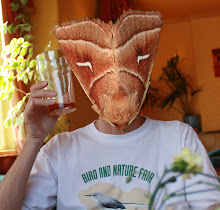
We are off up to the family cottage for a couple of weeks dodging the rain showers. So, I thought I'd better slip these images onto the old blog before I departed. Mike and I did another rapid moth clean-up session down at our favorite spot and, as usual, came home with some interesting records.
The weather was not the greatest. It was nice and muggy and cloudy as we were setting up the traps and lights but as dusk came around it cleared and cooled noticeably. However, we still recorded way over 200 species which seems to be the benchmark down here. Perhaps the coolest moth of the night was the one above
Catocala judith, or Judith's Underwing. I've long wanted to see this one. I like the "black" underwings and since this one is quite small too it always had some appeal for me. And so there it was, in the "Britney"trap. The Britney trap is a very special trap. It is made from a salvaged overhead light fitting - the sort you might find at a railway station and has a special Britney tube acting as the main funnel - you have to see it to appreciate it. It weighs an absolute ton (bit like the real thing - sorry Britney) and is a real pig to lug around. But we like her and she tries real hard to pull out all the stops to get "the big one" on each outing. Last time it was
Richia acclivis, this time
judith. BTW Judith's Underwing is very local in extreme southern Ontario, flies in July and August and the larvae feed on hickories and walnuts.

Before setting up we scoured the lines of flowers hoping for a gripping butterfly. There were none, but we did see a nice selection of pyralid moths around the flowers. Intriguing was a very small Pyrausta that I saw and then couldn't find again. I was convinced it was something interesting and was certainly new for me. After some searching we found at least four of these little sprites. I jarred one and photographed it the next morning, by which time it was sadly looking worse for wear. However, good enough to identify as
Pyrausta rubricalis. I don't know the status of this moth in the province as of yet.

Another interesting moth that appeared on one of the sheets was the tiny pyralid above. This one is
Acentria ephemerella, the Water Veneer. I've seen this one in UK but had no idea it occurred here in Ontario. I can find no reference to it in the literature I have at hand. Is pretty distinctive in its drabness! It is very small, a pale dove gray colour with a tiny white discal spot on each wing. They rarely survive the night so I was surprised this one did!

Another nice catch was the dagger moth above -
Acronicta oblinita, the Smeared Dagger Moth - but please don't be put off by the name! Is a nice-looking dagger that I don't catch very often and was a new species for the site. The adults are on the wing in spring and late summer in two broods whilst the larvae feed on a wide variety of trees, shrubs and plants.

Another moth that was new for us was this small noctuid called
Meganola phylla. We caught a couple of them but I wasn't entirely sure of the identification so consulted some expert help. Luckily the call was good. We also caught the look-alike sister species
M. minuscula, which is much more common and widespread, at least in Ontario.

















